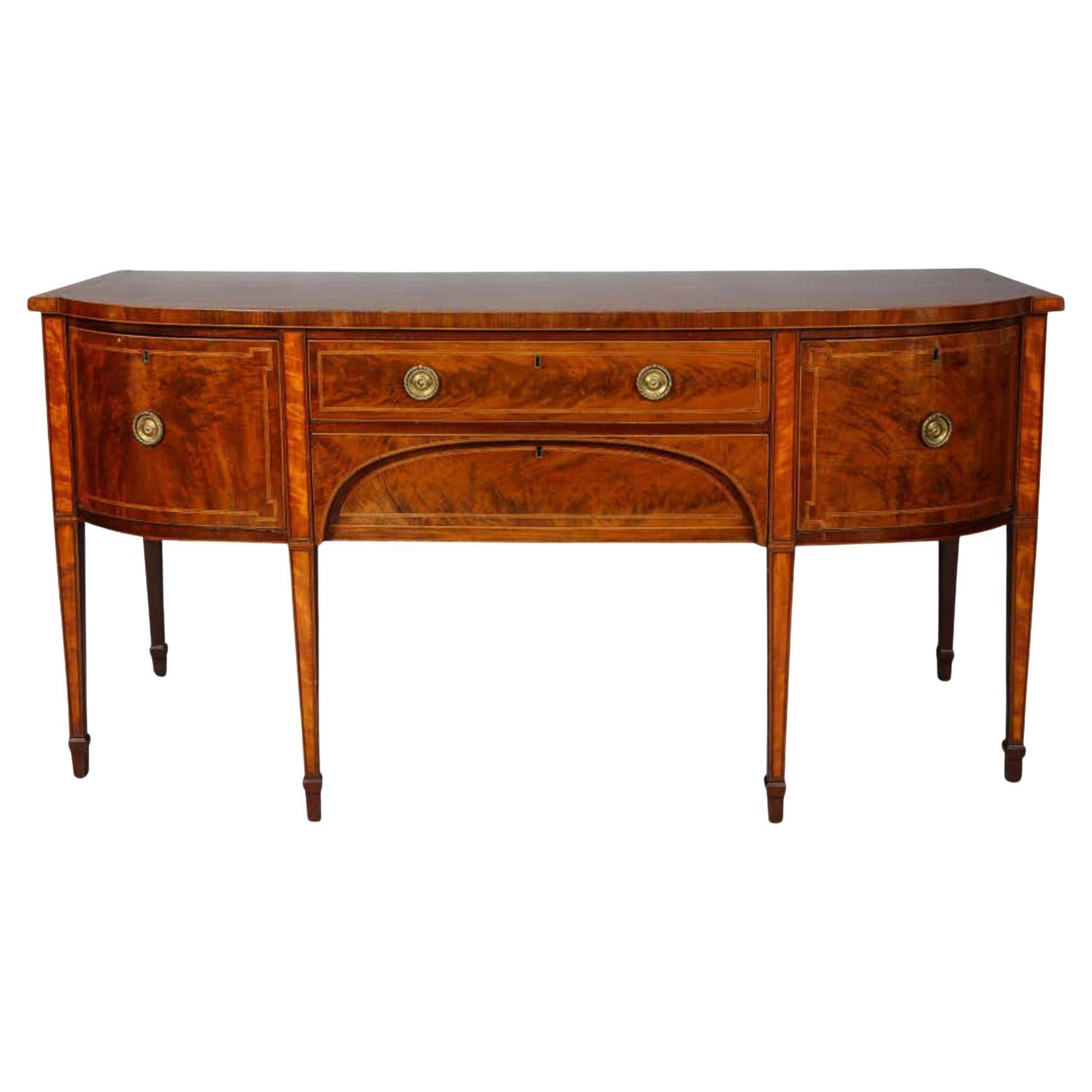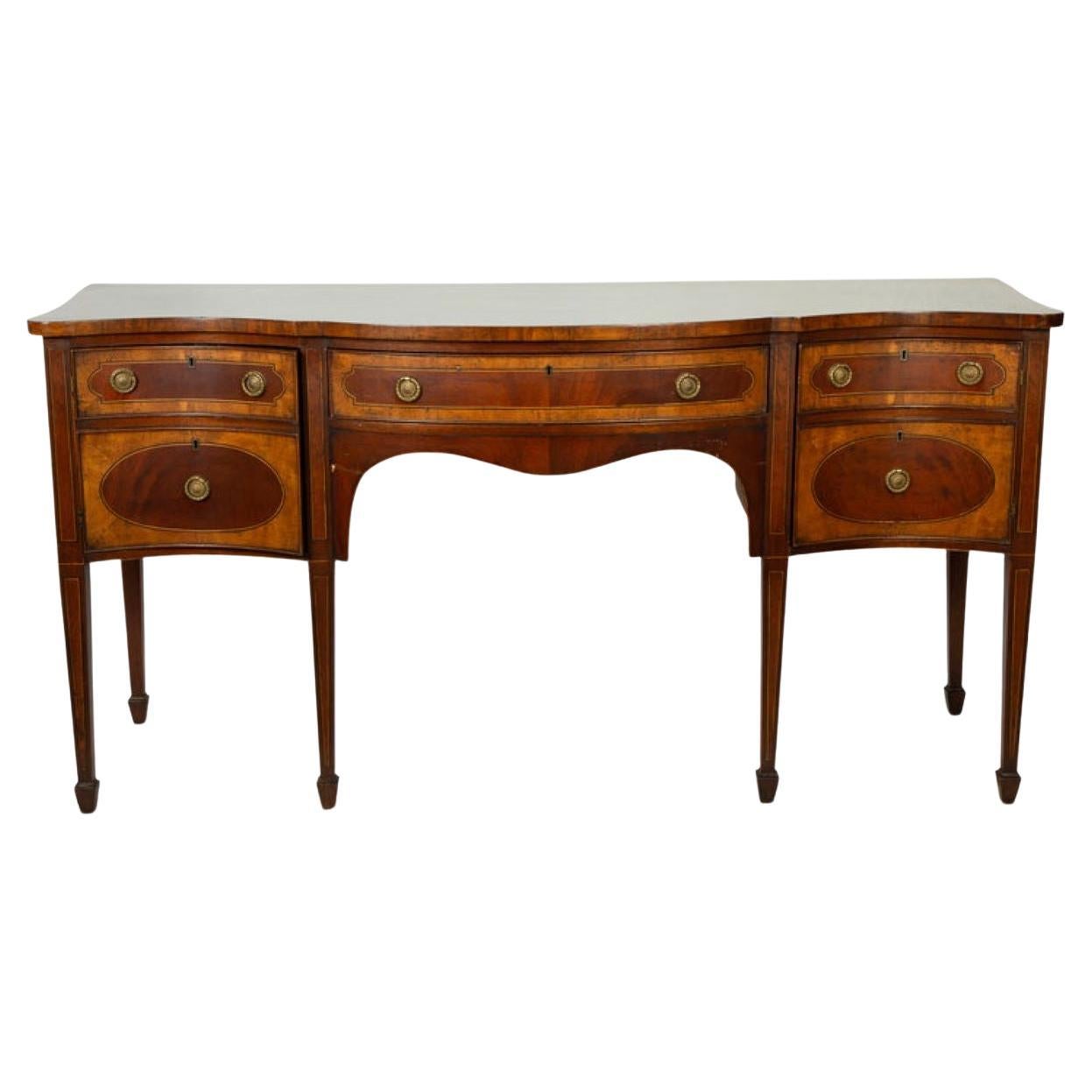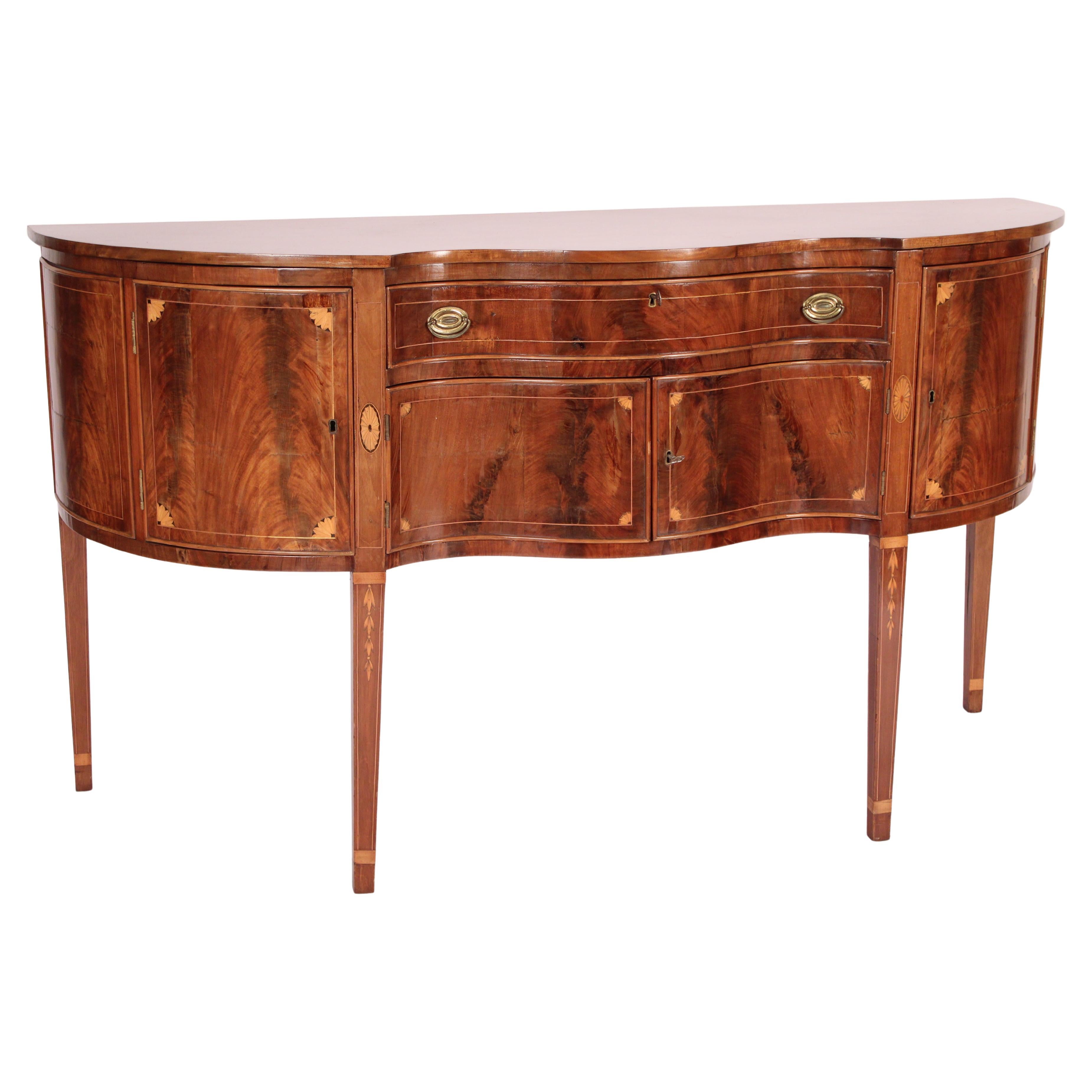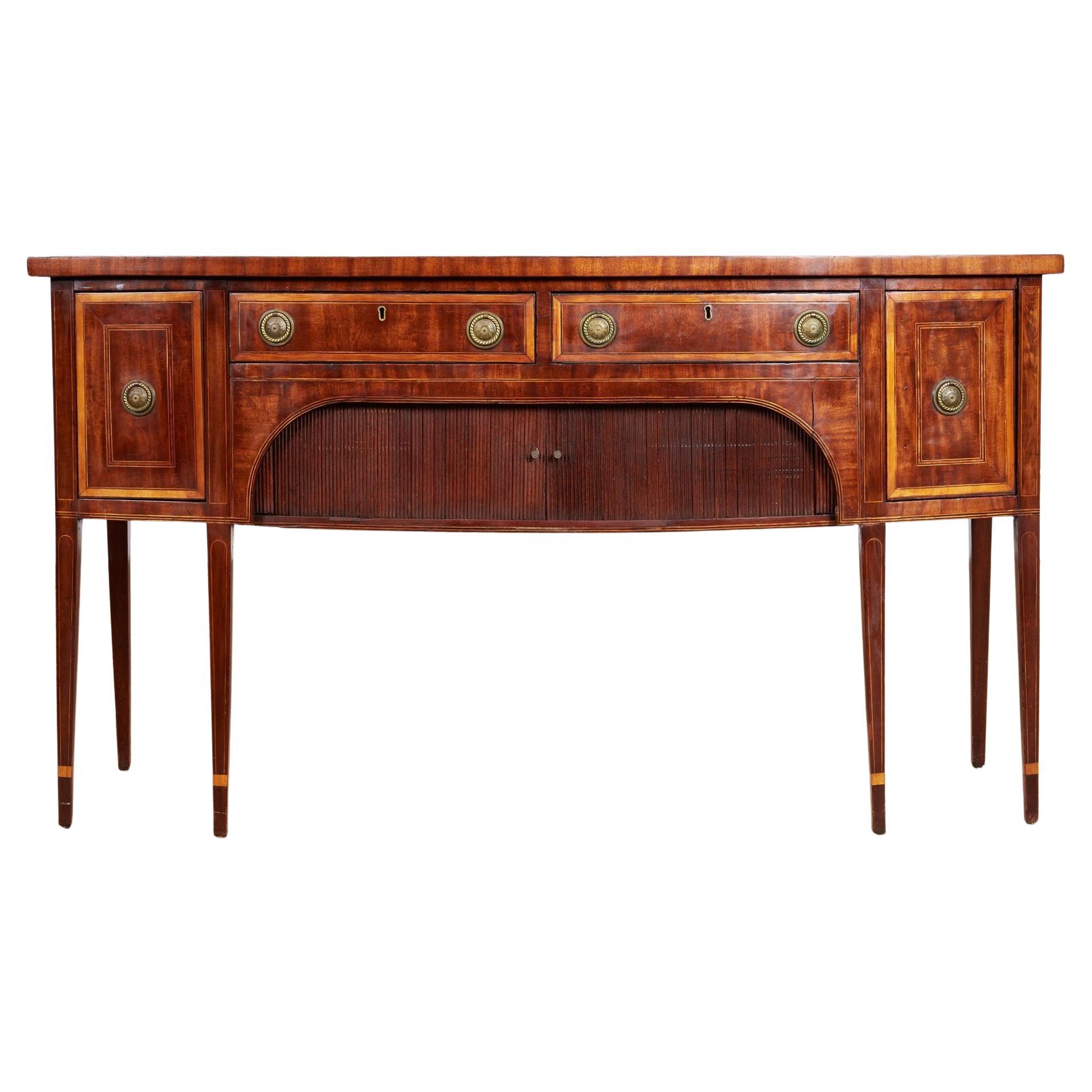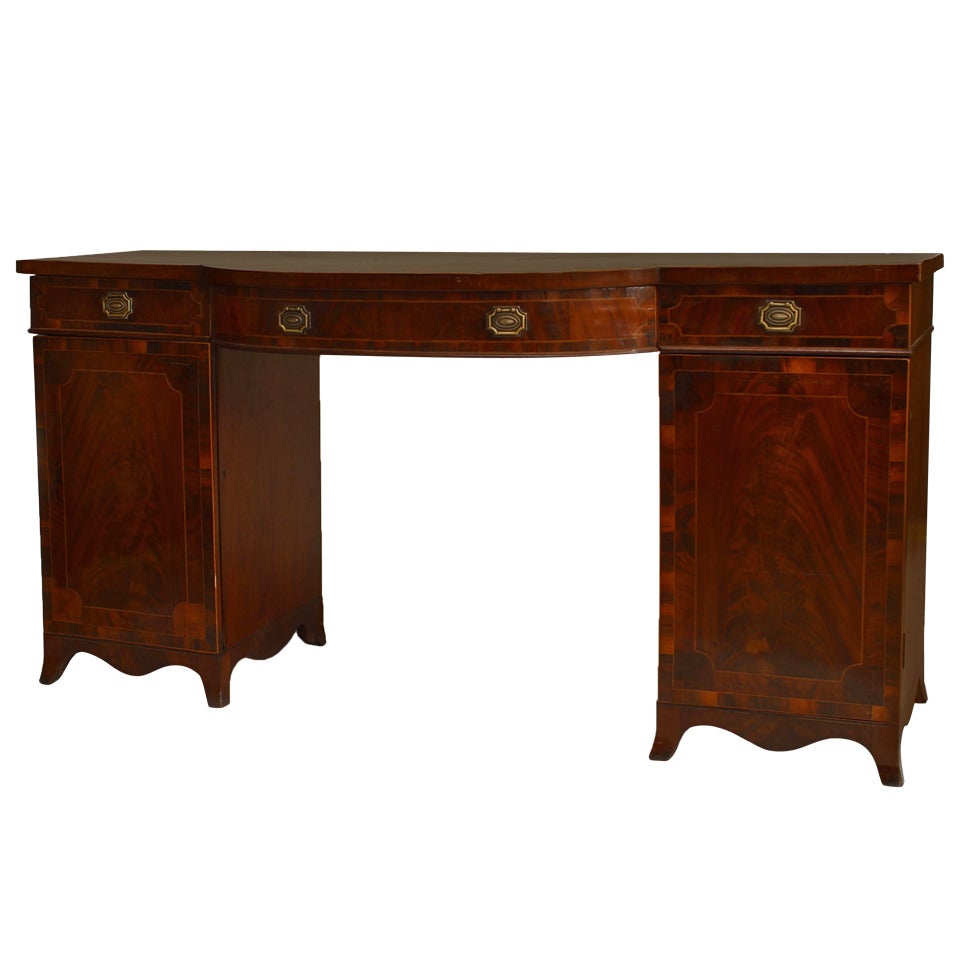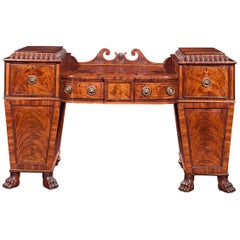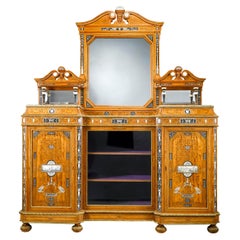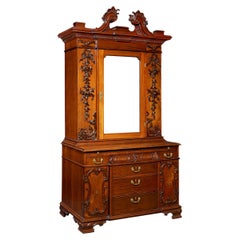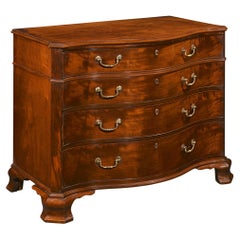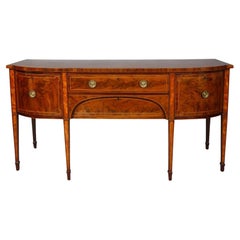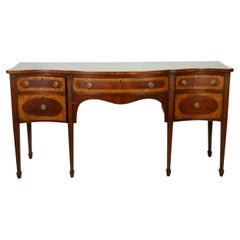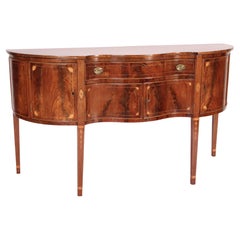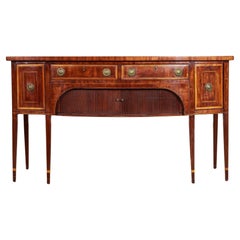Items Similar to George III Mahogany And Satinwood Sideboard
Want more images or videos?
Request additional images or videos from the seller
1 of 5
George III Mahogany And Satinwood Sideboard
$64,500
£49,274.60
€56,605.06
CA$92,346.79
A$101,016.93
CHF 52,631.14
MX$1,215,460.51
NOK 666,503.36
SEK 625,782.77
DKK 422,700.95
About the Item
This magnificent demi-lune Georgian sideboard displays the pinnacle of the era’s refined craftsmanship and boasts a distinguished provenance. Crafted of the finest mahogany, the era's timber of choice for well-appointed manor homes, the sideboard is inlaid with satinwood marquetry and crossbanded with tulipwood, one of the most coveted species of rosewood. Tulipwood is prized not only for its durability but also for its innate beauty. The sideboard features its original brass pull handles and knobs.
Illustrating the caliber of its exquisite craftsmanship, this large demi-lune sideboard was once housed in one of the most illustrious grand manor homes of the era, Hackwood Park. The luxurious piece of furniture served as a focal point in the incredible grand dining room of the impressive Hampshire estate.
The incredible 22-bedroom home was first constructed during the reign of Charles II (1630–85), and the main house has been improved and extended over the centuries. Covering over 260 acres, Hackwood Park was occupied by various noble families of the years, most notably the Bolton family. In fact, Jane Austen herself once danced in the halls of Hackwood Park at a gala hosted by the Duke of Bolton. The Austen connection remains ever prevalent as the home’s designer Lewis Wyatt also designed the Lyme Park estate, which served as the setting for Mr. Darcy's Pemberley in the BBC film adaptation of Pride and Prejudice.
A design for a similar large-scale demi-lune sideboard appears in Plate 5 Fig 1 of Thomas Shearer's The Cabinetmakers' London Book of Prices published in 1788.
Circa 1790
36 1/2" high by 107 5/8" wide by 37 1/2" deep
Provenance:
Hackwood Park, Hampshire, UK
Christie's London, 20-22 April 1998, lot 102
Private Collection, New York
M.S. Rau, New Orleans
- Dimensions:Height: 36.5 in (92.71 cm)Width: 107.63 in (273.39 cm)Depth: 37.5 in (95.25 cm)
- Style:Georgian (In the Style Of)
- Materials and Techniques:
- Place of Origin:
- Period:
- Date of Manufacture:Circa 1790
- Condition:
- Seller Location:New Orleans, LA
- Reference Number:Seller: 31-67191stDibs: LU891136806032
About the Seller
5.0
Recognized Seller
These prestigious sellers are industry leaders and represent the highest echelon for item quality and design.
Established in 1912
1stDibs seller since 2010
112 sales on 1stDibs
Typical response time: 8 hours
- ShippingRetrieving quote...Shipping from: New Orleans, LA
- Return Policy
Authenticity Guarantee
In the unlikely event there’s an issue with an item’s authenticity, contact us within 1 year for a full refund. DetailsMoney-Back Guarantee
If your item is not as described, is damaged in transit, or does not arrive, contact us within 7 days for a full refund. Details24-Hour Cancellation
You have a 24-hour grace period in which to reconsider your purchase, with no questions asked.Vetted Professional Sellers
Our world-class sellers must adhere to strict standards for service and quality, maintaining the integrity of our listings.Price-Match Guarantee
If you find that a seller listed the same item for a lower price elsewhere, we’ll match it.Trusted Global Delivery
Our best-in-class carrier network provides specialized shipping options worldwide, including custom delivery.More From This Seller
View All19th Century Regency Mahogany Pedestal Sideboard
Located in New Orleans, LA
This monumental English mahogany sideboard captures the luxury of the Regency era in grand style. Crafted in the neoclassical taste, the sideboard evokes the stately forms of ancient...
Category
Antique 19th Century English Regency Sideboards
Materials
Mahogany
Exhibition Satinwood Sideboard By Wright And Mansfield
By Wright and Mansfield
Located in New Orleans, LA
This extraordinary sideboard is attributed to the famed Wright and Mansfield and was only certainly created specifically for the important 19th century international exhibitions. Satinwood, ebony, marble and doré bronze of superior quality, are combined with a classical theme culminating in this neoclassical masterpiece. The 19th century marked an era dominated by significant global exhibitions, prompting artisans from diverse fields to push their creative boundaries in crafting exceptionally beautiful and pioneering works. These masterpieces were showcased before an international audience, frequently graced by nobility and royalty from various corners of the globe. The pinnacle of the firm's craftsmanship and artistry, this exquisite sideboard would certainly have been a showpiece for Wright and Mansfield.
Wright and Mansfield was an important and prominent Victorian firm that produced many of the finest pieces of English furniture ever made. They served as Cabinetmakers to Queen Victoria, and several of their pieces are housed and on display at the Victoria and Albert Museum in London. Widely recognized for their superb craftsmanship and innovative designs, they received acclaim for their works exhibited in the 1862 London International Exhibition, the 1867 Paris Exposition Universelle and the 1876 Philadelphia World...
Category
Antique 19th Century English Neoclassical Sideboards
Materials
Marble, Bronze
Mahogany Bureau Cabinet After Thomas Chippendale
By Thomas Chippendale
Located in New Orleans, LA
This extraordinary Irish bureau cabinet was crafted based on a design for a desk and bookcase drawn from Thomas Chippendale’s famed 1762 edition of The Gentleman and Cabinet-Maker's ...
Category
Antique 18th Century Irish Chippendale Cabinets
Materials
Mirror, Mahogany
George III Chippendale-Period Serpentine Commode
By Thomas Chippendale
Located in New Orleans, LA
This rare 18th-century serpentine chest of drawers was crafted in the style of the iconic Thomas Chippendale. The George III mahogany dresser is complete with its original brass hand...
Category
Antique 18th Century English Chippendale Commodes and Chests of Drawers
Materials
Brass
King George I Ambassadorial Secrétaire-Cabinet
Located in New Orleans, LA
This highly important secrétaire-cabinet was crafted for and specially ordered by King George I for the British Ambassador to Russia. From its craftsmanship and materials to its exceptional artistry, it is a work of royal and historic significance that exudes power in each and every detail. The broken pediment at its apex features the simplified royal coat of arms bearing the king’s crown, while the interior is adorned by portraits of the British Royal Family. Placed within the ambassador’s St. Petersburg home, this entirely unique piece of furniture would have been a potent reminder of England's grandeur and political importance.
Relations between England and Russia during this period were at an all-time high. Peter the Great had traveled to England in 1698 as part of his widely known “Grand Embassy” tour, wherein he attempted to gain foreign support against the Ottoman Empire. He spent a period of nearly four months there, meeting with King William III and his court on numerous occasions. Noted academic Arthur MacGregor wrote concerning the impact of the trip, “For two decades following Peter's visit, British influence in Russia reached a peak. It manifested itself in social custom, in craft practice and in ships and naval organization... it reached a significant sector of the population before relations cooled once again and the two nations pulled back from this era of unprecedented cordiality.”
First and foremost, however, it is a reminder of British might and influence. By the reign of King George I, England had come into its own as a world power. Unique in its design, this cabinet is a reflection of the country’s might. It is crafted from the highest-quality solid walnut and burr walnut adorned by gilded lock plates and engraved hinges. The presence of ormolu at its apex and lining the doors was a rarity for this period, and its addition makes manifest the importance of the design.
The outer doors open to reveal multiple interiors, including fifteen separate drawers around a central cupboard; the cupboard doors each bear mezzotint portraits of George I and his father, Ernest Augustus, Elector of Hanover. An etching after the portrait of George I dating to circa 1716 is in London’s Royal Academy. A second, inner pair of doors are adorned by mezzotints of the Prince and Princess of Wales (later Queen Caroline and George II), which are both after portraits by Sir Godfrey Kneller dated 1716 in the Royal Collection. A final portrait is revealed on the very interior of the cabinet, where a mezzotint of Frederick, Anne, Amelia and Caroline, children of the Prince of Wales, resides. An etching (circa 1715-1720) after this portrait can be found in the National Portrait Gallery (London).
Apart from its abundance of royal portraiture, the cabinet features stunning painted decoration, including floral designs as well as clouds, birds and trees in a bucolic motif reminiscent of Eden. Its lower portion is a study in both form and function, featuring a fitted secrétaire-drawer above three additional drawers for storage. The cabinet appears in The Shorter Dictionary of English Furniture by R. Edwards from 1964, a text that is regarded as the bible of British furniture design. Edwards describes it as a “writing cabinet...given by George I to the British Ambassador at the Russian court.”
The cabinet was likely made for the 18th-century German diplomat and writer Friedrich Christian Weber, who represented English interests at the Russian court from 1714 until 1719. Although Weber’s tenure as ambassador was relatively short, while in St. Petersburg, he authored his account entitled Das veraenderte Russland (The Present State of Russia), which was published in three volumes in 1721, 1739 and 1740. It may, however, also have been made for George Douglas, 2nd Earl of Dumbarton, who served as ambassador alongside Weber in 1716. Diplomatic relations ceased between the two countries in 1721.
In 1928, the cabinet appeared for sale at the International Exhibition of Antiques & Works of Art in Olympia. It had previously been in the collection of the Woltner family of Bordeaux, the celebrated vintners who owned the estate Château Laville Haut-Brion and produced wine of the same name. According to the family, Monsieur Woltner was given the cabinet as a gift from an aunt who lived in Russia for many years. After leaving the Woltner collection, the cabinet was acquired by William Berry...
Category
Antique 18th Century English Georgian Secretaires
Materials
Brass
18th Century English Secretary
Located in New Orleans, LA
Queen Anne period furnishings such as this walnut secretary are incredibly rare and important examples of English cabinetmaking. This secretary is of the most outstanding caliber, boasting desirable double bonnet, mirrored cabinet doors...
Category
Antique 18th Century English Queen Anne Secretaires
Materials
Walnut
You May Also Like
George III Sideboard
Located in Greenwich, CT
Very fine Georgian mahogany and satinwood stepped bow front sideboard, the richly figured top with ebony and holly string inlay over two deep and shallow drawers also strung with ebo...
Category
Antique 1780s English Georgian Sideboards
Materials
Mahogany, Satinwood
$9,800
George III Style Mahogany Sideboard
Located in Atlanta, GA
A Very Fine George III style Mahogany Sideboard. England, circa 1920.
Dimensions: Height 36 1/2 x Width 70 3/4 x Depth 24 3/4 inche...
Category
Vintage 1920s English George III Sideboards
Materials
Wood
Antique George III Style Mahogany Sideboard
Located in Laguna Beach, CA
Antique George III style mahogany inlaid sideboard, 19th century. With a two board mahogany top, a central drawer with cock beaded moldings and string inlay over two doors with fan i...
Category
Antique 19th Century English George III Sideboards
Materials
Brass
Narrow Georgian Mahogany and Satinwood Sideboard
Located in Greenwich, CT
George III mahogany sideboard of desirable narrow proportions, the "D" shaped top with vivid graining and cross-banded in satinwood with ebony and holly stringing, over bow fronted s...
Category
Antique Late 18th Century English Hepplewhite Sideboards
Materials
Mahogany
English Georgian Mahogany Sideboard
Located in Queens, NY
English Georgian mahogany sideboard with bow shaped front and inlaid with cross-banding and panels on either side of center front drawer.
Category
Antique 19th Century English Georgian Sideboards
Materials
Mahogany
English Georgian Mahogany Satinwood Sideboard
Located in Queens, NY
English Georgian (18th Century) mahogany satinwood banded sideboard or desk with a bow front supported by a double pedestal base. (3 sections)
Category
Antique 18th Century and Earlier English Georgian Sideboards
Materials
Brass
More Ways To Browse
Antique Brass Cross
Georgian Cross
Jane Austen Antique
Large Demi Lune
George Iii Sideboard Inlay
George Iii Server
Maurice Rinck
Mid Century Sideboard Extra Long
Mid Century Tall Sideboard
Norway Sideboard
Rosewood Skovby
Sideboard With Gallery
Sideboard With Wood Handles
Vintage Bass Cabinet
1920 Server
19th Century American Sideboard
Antique Cherry Sideboard
Antique Wood Server
